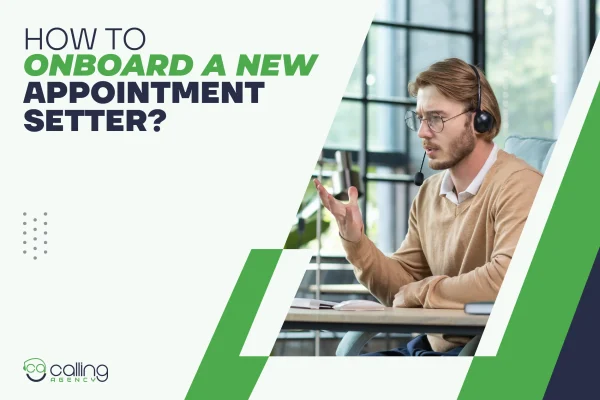Are you worried about how to onboard a new appointment setter for your call center? Well, onboarding new agents may seem challenging, but it’s not. You can easily onboard a new appointment setter by having a well-structured onboarding plan. 20% of turnover occurs within the first 45 days of taking a new appointment setter.
If you want your new appointment-setting agents to perform well and generate results, you must onboard them effectively. But how can you onboard a new appointment setter efficiently without compromising quality and productivity?
Let’s look at the best practices for onboarding a new appointment setter from the hiring process to the first day and beyond.
How To Onboard A New Appointment Setter
An appointment setter is a vital member of any sales team. They are responsible for contacting leads, qualifying them, and scheduling appointments for the sales representatives.
You must form the right B2B appointment-setting team for your call center to generate high-quality sales leads. For this, you have to hire and onboard new appointment setters and train them to become skillful. An appointment setter efficiently reaches out to potential clients and sets an appointment.
To onboard a new appointment setter, you must first design an onboarding plan and start hiring. After hiring, you must help the new hire adjust in your call center from their first day at work. You have to understand that no employee will hit high-performance targets in the first few days. It can take about 12 weeks for a new appointment setter to adapt and display total productivity levels at work.
So, you must ensure a good environment and provide ongoing support for your new appointment setter to become settled. Now, let’s jump into onboarding a new appointment setter.
1. Having a Structured Onboarding Plan
The first step to onboarding a new appointment setter is to have a structured and detailed onboarding plan. It should cover all the aspects of their role, expectations, goals, and feedback.
Create a clear job description that outlines the appointment setter’s duties, responsibilities, skills, and qualifications. Then, list the tools, software, and resources the appointment setter will need to use and access.
Further, craft a schedule of the training sessions, meetings, and check-ins that the appointment setter must attend, along with each session’s topics, objectives, and outcomes. Also, you have to set key performance indicators (KPIs) and metrics to measure and evaluate the appointment setter’s progress and performance.
A structured onboarding plan will help you onboard a new appointment setter systematically. It will ensure the new hire understands the role, expectations, and goals.
2. Start Hiring Them On Tuesday
One of the best tips to onboard a new appointment setter is to start hiring them on Tuesday rather than Monday or any other day of the week. Why is that? According to research and experts, Tuesday is the most productive day and the optimal day for both the employer and the employee.
Tuesday is the most productive day of the week for most people as they have already settled into their work routine and are not distracted by the weekend or the midweek slump. It means you and the new appointment setter will be more focused, motivated, and efficient on Tuesday. Avoid hiring new appointment setters on a Monday. On Mondays, you’re probably busy with internal meetings, follow-ups, or Zoom calls.
By hiring a new appointment setter on Tuesday, you can onboard them more productively and positively. Also, it will help them adapt and integrate faster and more efficiently. It is the ideal day to introduce a new appointment setter to the team and the company culture.
They will be able to meet and interact with more people and get a better sense of the work environment and values. They will also be able to participate in more team activities and events and build relationships with their colleagues and managers.
3. Communicate What Their First Day Will Entail
Another vital tip to onboard a new appointment setter is to communicate their first day before they arrive at the office. It will help them prepare, plan, and reduce anxiety and uncertainty.
By communicating what their first day will entail, you can onboard a new appointment setter more smoothly and seamlessly. It will make them feel more comfortable and confident.
Inform them of the time and location of their arrival and the schedule of their first day before onboarding them. Moreover, notify them about the dress code and etiquette of the office, as well as the documents and items they will need to bring.
4. Make Sure That They Have Actual Assets
You must ensure your new appointment setters start working and producing results from their first day. Prepare a dedicated and functional workstation with a phone, a computer, a headset, and a comfortable chair and desk.
Furthermore, create a personalized and secure email account for them, with a professional and friendly signature and a clear and concise autoresponder. Also, provide them with a list of qualified and verified leads they can contact and follow up with. Additionally, give them a handbook and guide containing all the information and instructions they need to know and follow.
Create a one-pager containing all your hyperlinks to your call center’s script, calendar link, and every important document. It will ensure they have everything they need to set appointments successfully. It will reduce getting anxious and messing up finding a link or going into the tabs during mid-calls. They can use this one-page document forever, making their job easier.
Moreover, ensure they can access your assets, starting from the sales deck, company website, testimonials, case studies, and call recordings from day one.
5. Have a Role Play
Role play is massive in the first one to two weeks. A role play is a mock call situation where the appointment setters will pretend to be doing their job, and you will pretend to be a prospect on the other end of the phone.
Suppose you want to test your new appointment setter’s performance for insurance appointment setting. For that, create a real-life scenario where you seek an insurance service, and your new hire is an insurance appointment setter.
This mock call should mimic the actual situations and challenges appointment setters can face in their role. It will reflect their ability to deal with different types of prospects, handle common objections, and close the appointment.
Avoid getting hard on them or giving them crazy objections on their first few days. But also don’t take it too lightly on them. Your job will be to make it a real-life situation. After that, let them practice on their own and improve their pitch. Once they practice it, have another role play and see how well they’ve improved from the last one.
6. Script, Product, and CRM Training Plan
A convincing script, product, and CRM training plan will teach new onboarded appointment setters how to use and master these three key elements of their role.
A script covers all the stages and steps of the appointment-setting process, such as the introduction, the qualification, the presentation, the objection handling, the closing, and the follow-up.
In addition, a product solves the pain points and meets the needs and goals of the target audience. The appointment setter should understand the product’s features, benefits, and advantages. They should also know how to communicate effectively and persuasively with the leads.
Besides, a CRM helps the appointment setter to manage and organize their leads, appointments, and tasks. The appointment setter should know and understand how to use and operate the CRM. Also, it will guide them in updating and tracking their activities and results.
7. Create a Good Environment
Sales lead generation through appointment setting can be stressful work. The rejection rate is high, and the success rate is low. So, new appointment setters of your agency may feel demotivated. Creating a good environment can help your calling agents find motivation after rejection.
A good work environment will help you to onboard a new appointment setter more humanly and emotionally. A friendly and positive team and company culture will help the new appointment setters feel welcome, valued, and supported. It will also make them feel more loyal and committed to their role and the company.
In addition, provide a respectful work environment where a new appointment setter can express and share their opinions and ideas. It will allow them to address and resolve any issues or conflicts.
8. Ongoing Support
Provide new appointment setters with ongoing support, even after their initial training and orientation period. It will help you to onboard a new appointment setter in a more long-term and sustainable way. It will also ensure they grow and succeed in their role and the company.
You can provide ongoing support by scheduling regular check-ins and providing daily feedback. It will access the new appointment setter’s progress and address their questions or concerns. Also, offer them in-depth training on your call center’s products or services. It will help them get a clear insight into the features, benefits, and value proposition.
Moreover, pair them with an experienced call center agent for guidance and assistance. You should always encourage the new appointment setter to observe how skillful agents handle calls and appointments.
9. Balancing Performance Metrics
One of the most challenging tips for onboarding a new appointment setter is balancing their performance metrics. You must ensure they meet and exceed their role’s quantity and quality standards.
Performance metrics are the numerical and measurable key performance indicators (KPI) that reflect and evaluate the appointment setter’s output and outcome, such as the number of calls made, the number of appointments booked, the conversion rate, the quality score, etc.
Balancing performance metrics requires a lot of practice, discipline, and feedback. Performance metrics help to improve call center agent performance. Provide new appointment setters with clear and realistic goals and expectations. Furthermore, monitor and track their performance metrics using the KPIs to understand if they are maintaining quality.
It’s crucial to identify and analyze their strengths and weaknesses and provide them with tips to improve and boost their performance metrics. Most importantly, encourage and motivate them to challenge themselves and push their limits.
10. End of Day Meeting
An end-of-day meeting is a regular meeting with your new hire at the end of each working day to review their progress, performance, and challenges. This meeting should be brief, constructive, and motivational.
It should last no more than 15 minutes and focus on the positive and solutions rather than the negative aspects and the blame. It should also end on a high note and encourage your new appointment setter to keep up the good work and improve their skills.
This super quick meeting helps you to check in with the new agents. End-of-day meetings let you understand if your new employees are overwhelmed or have questions. It will also assist you to know what they like, don’t like, or need within the call center.
Conduct these meetings daily for the first one or two months. After that, lessen the end-of-day meetings and hold them once or twice weekly.
Summary
Most call centers face a high turnover or call center attrition rate constantly. So, it is necessary to onboard a new appointment setter with proper planning.
This article has shared some tips and best practices on how to onboard a new appointment setter effectively and efficiently. By following these steps, you can create a smooth and positive onboarding experience for your new appointment setters and set them up for long-term success.








